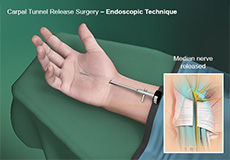
What is Capal Tunnel Syndrome?
The carpal tunnel is a narrow passageway on the palm side of your wrist. Small wrist bones known as carpals form the bottom and sides of the carpal tunnel and a strong band of connecting tissue, known as the transverse carpal ligament, covers the top of the carpal tunnel.
The carpel tunnel houses the flexor tendons, that allow you to bend your fingers, and the median nerve, which provides sensation to most of your fingers and hand. Special tissues known as synovium surround and lubricate the flexor tendons in your wrist, allowing smooth movement of the fingers. Carpal Tunnel Syndrome occurs when the synovium swells, narrowing the limited space within the tunnel, and pinches the median nerve over time. The transverse carpal ligament can also become tight causing narrowing of the carpal tunnel space and pressure on the median nerve.
Signs and Symptoms
Some of the common symptoms associated with Carpal Tunnel Syndrome include:
- Numbness and tingling in the thumb, index, and middle fingers
- Pain and burning in the hand and wrist that may radiate up the arm to the elbow
- Decreased sensation and weakness in the hand with diminished grip strength
- Worsening of symptoms at night
Causes
The following factors have been known to increase a person’s risk of developing carpal tunnel syndrome:
- Repetitive Motion: performing heavy, repetitive hand and wrist movements with prolonged gripping at work or play
- Congenital: Some people are born with narrow carpal tunnel canals.
- Trauma: Injury to the wrist such as fractures or sprains.
- Hormonal Changes: Pregnancy, menopause, birth control pills or hormone pills are risk factors as they alter the levels of hormone in the body.
- Medical Conditions: Conditions such as hypothyroidism, rheumatoid arthritis, diabetes, obesity, gout, overactive pituitary gland, or the presence of a cyst or tumor extending to the carpal tunnel.
Diagnosis
Your doctor diagnoses carpel tunnel syndrome by performing a detailed medical history and physical examination. Further tests may be ordered including an X-ray to view your wrist bones, blood tests to rule out underlying medical conditions such as diabetes, arthritis and thyroid problems, and electrodiagnostic testing to assess the speed and degree of electrical activity in your nerves and muscles.
Treatment
Carpel tunnel can be treated with conservative measures or surgical intervention. Conservative treatment options may include treating any underlying medical conditions, such as diabetes and arthritis. Your hand and wrist may be immobilized with a splint or wrist brace for 4 to 6 weeks. Ice packs may be recommended to keep down any swelling. You may be advised to avoid activities that tend to bring on the symptoms. Medication and steroid injections may be used to treat pain and swelling. You may be referred to therapy to be taught strengthening and stretching exercises.
Endoscopic Carpal Tunnel Release Surgery
When conservative treatment options are not effective, surgery may be recommended. Endoscopic Carpal Tunnel Release surgery is advised:
- when symptoms of pain and weakness do not improve after a long period of conservative treatment,
- the symptoms are getting severe and restricting normal daily activities,
- or there is a risk of irreversible damage.
Surgical Procedure
The surgery is performed by administering local anesthetic into the wrist and palm of your hand. You will be awake and may feel pressure, but will not feel any pain during the procedure.
- A single incision is made in the wrist. Sometimes, your surgeon may make two incisions – one on the wrist and the other on the palm.
- A tube with a slot on the side called a cannula is inserted through the incision and placed next to the median nerve, just under the offending transverse ligament.
- An endoscope, a thin, flexible tube with a camera attached is passed through the cannula to look at the carpal ligament from below. The images from the endoscope are visible to the surgeon on the video monitor in the operating room. Your surgeon ensures that the nerves and arteries are not in the way while cutting the ligament.
- A special cutting tool with a hook is inserted into the cannula.
- As the tool is pulled back out of the cannula, it cuts the carpal ligament and releases the pressure over the median nerve.
- The cut ends of the ligament eventually fill in with scar tissue.
- The skin incision is closed with dissolvable stitches and a dressing is placed.
- The arm may be put in a sling to provide extra support and reduce swelling.
- The procedure usually takes about 20 minutes to complete.
Post-operative Care
Following surgery, your wrist will be wrapped in a bandage or splint for about a week. You will be prescribed pain medication to keep your comfortable.
Some common postoperative guidelines include:
- Elevate your hand above the level of your heart and move your fingers to reduce stiffness and swelling.
- Keep the surgical incision clean and dry. Cover the area with a plastic wrap when bathing or showering.
- Eat a healthy diet and quit smoking to promote healing
- Avoid heavy pinching or grasping actions for six weeks to avoid irritating the wrist.
- You will be started on a physical therapy program where you will be instructed on special exercises to improve the movement of your hand and wrist.
Risks and Complications
Some of the potential complications of carpal tunnel release surgery include
- Infection
- Damage to the nerves causing weakness, paralysis, or loss of feeling in the hand and wrist area
- Pain and stiffness to the wrist and hand
- Wrist weakness and loss of strength due to injured tendon
- Worsening of symptoms or symptoms not improved after surgery
Advantages
Endoscopic carpel tunnel surgery has the following advantages when compared to traditional open carpel tunnel surgery:
- Smaller incision
- Faster recovery
- Reduced post-operative pain
- Reduced post-operative complications
- Lower risk of damage to neighboring nerves and blood vessels
